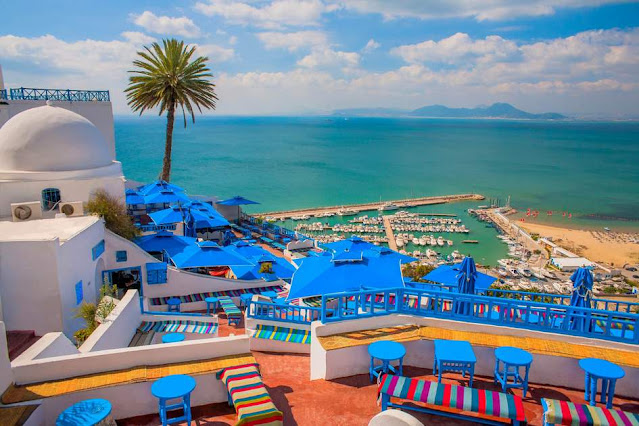Wikipedia
Search results
Tuesday, 3 June 2025
Top 10 Tourist Locations in Tunisia
Introduction
Tunisia, a captivating blend of Mediterranean charm, ancient history, and North African culture, is a traveler’s dream waiting to be explored. Nestled between Algeria and Libya, with a stunning Mediterranean coastline, Tunisia offers everything from sun-soaked beaches and bustling souks to Roman ruins and desert landscapes. Though small in size, it brims with historical treasures, architectural wonders, and warm hospitality. Whether you’re looking for relaxation, cultural immersion, or adventure, Tunisia delivers. Here are the top 10 tourist locations that showcase the diverse magic of this North African gem.
1. Tunis – A Cultural Crossroads
The capital city, Tunis, effortlessly blends the old and new. Its heart lies in the Medina, a UNESCO World Heritage Site filled with winding alleys, traditional markets (souks), and centuries-old mosques. The Zitouna Mosque and Dar Ben Abdallah museum are highlights here. Not far from the Medina, the more modern side of Tunis boasts cafes, art galleries, and a thriving nightlife. Tunis also serves as the gateway to many historical sites, making it a strategic and culturally rich base for travelers.
2. Carthage – Echoes of Empire
Just outside Tunis lies the ancient city of Carthage, once the powerful capital of the Carthaginian Empire and later a Roman stronghold. Today, visitors can wander through evocative ruins, including the Antonine Baths, Byrsa Hill, and the Carthage Museum. The location’s sea views add beauty to its historical significance. Carthage offers a unique journey back in time for lovers of archaeology and classical history.
3. Sidi Bou Said – A Cliffside Dream
Perched above the Mediterranean Sea, Sidi Bou Said is a picturesque village known for its whitewashed buildings with blue doors and shutters, cobbled streets, and stunning cliffside views. Artists and writers have long been drawn to its charm, and it remains a favorite spot for romantic getaways and leisurely strolls. Don’t miss Café des Délices for a panoramic view of the Gulf of Tunis.
4. El Djem – The Roman Colosseum of Africa
In the heart of Tunisia lies El Djem, home to one of the largest and best-preserved Roman amphitheaters in the world. This massive structure once hosted gladiator fights and could hold up to 35,000 spectators. Walking through its vast corridors and seating tiers is a powerful experience that rivals a visit to Rome’s Colosseum. The nearby museum houses mosaics and relics that add context to this awe-inspiring site.
5. Kairouan – Sacred and Serene
Kairouan, Islam’s fourth holiest city, is revered for its spiritual significance and architectural beauty. The Great Mosque of Kairouan, dating back to the 7th century, is a masterpiece of Islamic design. Beyond its religious importance, the city is known for traditional crafts, especially handwoven carpets. A walk through the old medina offers a peaceful, contemplative experience far from tourist crowds.
6. Djerba – Island Escape
Djerba is Tunisia’s most popular island getaway, offering sandy beaches, turquoise waters, and a laid-back atmosphere. The island’s cultural richness is also notable, with influences from Arab, Berber, and Jewish communities. Houmt Souk, the main town, features colorful markets, while the El Ghriba Synagogue—one of the oldest Jewish temples in the world—offers spiritual and historical intrigue. Djerba is perfect for both relaxation and exploration.
7. Matmata – Homes Beneath the Earth
Famous for its troglodyte dwellings, Matmata is where locals have carved homes into the earth to escape the desert heat. These unique underground houses gained international fame as a filming location for Star Wars. Visitors can tour a traditional Berber home and learn about this ingenious way of life. The lunar-like landscape adds to the otherworldly atmosphere.
8. Tozeur – Oasis of Palm Trees
Located at the edge of the Sahara Desert, Tozeur is known for its lush palm groves and traditional brickwork architecture. It’s also a launching point for desert adventures, including camel rides and trips to the mountain oases of Chebika and Tamerza. Tozeur’s old quarter, with its narrow lanes and geometric designs, is a window into Tunisia’s desert culture.
9. Dougga – Tunisia’s Pompeii
Dougga is an archaeological treasure set against rolling hills and olive groves. Once a thriving Roman town, its ruins include a well-preserved theater, temples, baths, and public squares. The site is peaceful and less crowded, offering an immersive experience into Roman life without the distractions of modern development.
10. Sahara Desert – The Endless Adventure
No trip to Tunisia is complete without experiencing the vast Sahara. From the dunes of Douz to the salt flats of Chott El Jerid, the desert landscape is mesmerizing. Activities include jeep tours, star-gazing nights, sandboarding, and visits to nomadic encampments. For the adventurous soul, a trek into the Sahara is a transformative journey.
Conclusion
Tunisia is a land where Mediterranean breezes meet Saharan sands, and ancient civilizations echo through modern cities. With a tapestry of cultures, flavors, and landscapes, it offers an unforgettable adventure for every traveler. Whether you’re marveling at Roman ruins, relaxing on island beaches, or exploring sacred sites, Tunisia will surprise and enchant you at every turn.
Subscribe to:
Post Comments (Atom)
18 Things You Didn't Know About Africans
Africans were the first mathematicians in the world. People from West and Central Africa, like the Ishango bone from Congo (20,000+ years ...

-
The history of African-Australians is a story of migration, colonization, and cultural integration. While African presence in Australia can ...
-
Introduction South Sudan, the world’s youngest nation, is a land rich in culture, resilience, and vibrant traditions. Though it has faced m...
-
Introduction Tucked away in West Africa and straddling the vast Sahara Desert, Niger may not be the first place that comes to mind when one...




No comments:
Post a Comment